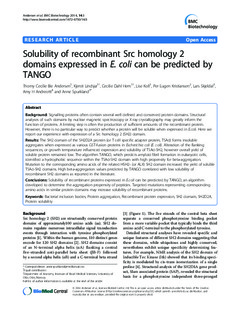| dc.description.abstract | Background: Signalling proteins often contain several well defined and conserved protein domains. Structural
analyses of such domains by nuclear magnetic spectroscopy or X-ray crystallography may greatly inform the
function of proteins. A limiting step is often the production of sufficient amounts of the recombinant protein.
However, there is no particular way to predict whether a protein will be soluble when expressed in E.coli. Here we
report our experience with expression of a Src homology 2 (SH2) domain.
Results: The SH2 domain of the SH2D2A protein (or T cell specific adapter protein, TSAd) forms insoluble
aggregates when expressed as various GST-fusion proteins in Escherichia coli (E. coli). Alteration of the flanking
sequences, or growth temperature influenced expression and solubility of TSAd-SH2, however overall yield of
soluble protein remained low. The algorithm TANGO, which predicts amyloid fibril formation in eukaryotic cells,
identified a hydrophobic sequence within the TSAd-SH2 domain with high propensity for beta-aggregation.
Mutation to the corresponding amino acids of the related HSH2- (or ALX) SH2 domain increased the yield of soluble
TSAd-SH2 domains. High beta-aggregation values predicted by TANGO correlated with low solubility of
recombinant SH2 domains as reported in the literature.
Conclusions: Solubility of recombinant proteins expressed in E.coli can be predicted by TANGO, an algorithm
developed to determine the aggregation propensity of peptides. Targeted mutations representing corresponding
amino acids in similar protein domains may increase solubility of recombinant proteins.
Keywords: Bacterial inclusion bodies, Protein aggregation, Recombinant protein expression, SH2 domain, SH2D2A,
Protein solubility | nb_NO |

